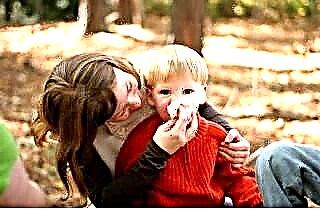Acute nasopharyngitis in children is a commonly diagnosed ailment that can be of bacterial or viral origin. Unlike simple pharyngitis, rhinitis, tonsillitis and some other isolated viral diseases, acute rhinopharyngitis in children affects both the pharynx and the nasal cavity. As a rule, such a disease is most often diagnosed in babies in preschool age, which is easy to explain by the not fully formed immune system and the anatomical structure of the children's nasopharynx.
Medical statistics eloquently indicate that every child suffers from such an ailment from 4 to 7 times in one year. In addition, it is worth noting some seasonality of rhinopharyignitis. The peak incidence occurs precisely in the autumn and winter periods; in summer and spring, such a disease is diagnosed much less often.
Causes
 At the moment, doctors record a fairly large range of different viruses that cause the appearance of an acute respiratory viral infection (ARVI), which in turn is accompanied by inflammatory processes in the pharynx and nasal cavity. But in addition to viral infections, rhinopharyngitis in children can occur due to contact with the following types of bacteria:
At the moment, doctors record a fairly large range of different viruses that cause the appearance of an acute respiratory viral infection (ARVI), which in turn is accompanied by inflammatory processes in the pharynx and nasal cavity. But in addition to viral infections, rhinopharyngitis in children can occur due to contact with the following types of bacteria:
- mycoplasma;
- streptococci;
- chlamydia;
- diphtheria sticks;
- staphylococci and so on.
Do not forget about the allergic factor - another initiator of inflammatory processes. The mechanism of development of the disease is simple. A bacterium or a virus enters the pharynx or nasal mucosa and starts an active reproduction process. The body's response is mucosal inflammation. As a result, a mucous secret begins to be actively secreted, pain and discomfort arise.
Rhinopharyngitis in a child is a frequently diagnosed ailment, but not all children get sick with it. Why it happens? The fact is that in addition to the viral basis, there must be a complex of factors that contribute to the appearance of such a disease.
These factors include the following:
 weakened immunity (for example, due to a recent illness);
weakened immunity (for example, due to a recent illness);- deficiency of vitamins in the child's diet;
- the influence of external environmental factors;
- a sharp change in climate (temperature drops);
- hypothermia;
- foci of infection inside the child's body;
- secondhand smoke (when parents smoke at home).
The so-called bacterial rhinopharyngitis in most cases is caused by improper or insufficient treatment of a particular viral infection (it can be found not only in the nasopharynx, but also in any other place). Take, for example, the abuse or misuse of strong antibiotics (or, conversely, abandoning them too early). This factor entails the occurrence of rhinopharyngitis.
Symptoms
Rhinopharyngitis in children, the symptoms of which can be very different, most often begins in the form of rhinitis, that is, a runny nose. This is explained again by the anatomical features of the structure of the children's nasopharynx. Another characteristic symptom is a sore throat. It is worth noting that such a disease in young children is always more complicated than in adults.
If an acute respiratory viral infection is caused by the so-called RS virus, then in adults the clinical picture consists of general weakness, sore throat and a slight runny nose. The disease can proceed even without a rise in temperature.
In young children (especially in infants), rhinopharyngitis is very often complicated by pneumonia and is not complete without hospital treatment. Such an ailment can manifest itself in both acute and chronic forms. But the general symptoms for them will be the same:
 difficulty breathing through the nose;
difficulty breathing through the nose;- rhinitis;
- sneezing attacks;
- stuffy nose;
- severe coughing attacks at night;
- cough - as a result of dry mucous membranes;
- irritation, swelling and redness of the back of the throat;
- general weakness and malaise;
- painful sensations during swallowing;
- in some cases, there is an increased temperature.
If we talk about the acute form, then in this case the symptoms will be pronounced in the range from 5 to 10 days. When a mycoplasma or chlamydial infection has become the source of the onset of the disease, the rehabilitation period stretches for two weeks. The chronic form, in turn, can manifest itself in a hypertrophied form (thickening of the mucous membrane, swelling, redness), catarrhal (no symptoms), atrophic (thinning of the mucous membrane, pallor). With the atrophic form of rhinopharyngitis, permanent sore throat is diagnosed, with the other two - mucus secretion.
Drug treatment
Various groups of drugs are used as therapeutic agents, namely:
- Medicines for narrowing the nasal vessels. Most often, doctors prescribe Otrivin, Vibrocil, Nazivin and some other drugs. But they only reduce the intensity of the manifestation of symptoms and only for a while.
- Medicinal nasal drops help well. Protargol has proven itself very well (such a pharmacy medicine is dispensed only by prescription). For kids from 2 years old and older, Pinosol drops are suitable. In some cases, complex medications may be prescribed to narrow blood vessels and fight infection. The composition is selected by the attending physician, taking into account the individual characteristics of the child.
 Antihistamines allow you to quickly cope with swelling of the nasal cavity, mucus and lacrimation. In this case, we are talking about "Tavegil", "Fenistil", "Suprastin" and some others (they can be assigned to children from one month old).
Antihistamines allow you to quickly cope with swelling of the nasal cavity, mucus and lacrimation. In this case, we are talking about "Tavegil", "Fenistil", "Suprastin" and some others (they can be assigned to children from one month old).- If the infection is localized in the throat, absorbable tablets and sprays are used. But sprays are not suitable for everyone - they are contraindicated for small children under 4 years old, as they can cause laryngospasm. From the age of five, you can start practicing gargles based on sage, chamomile and calendula. If you wish, you can buy ready-made rinsing medicines - "Stomatidin", "Givalex" and so on.
- Reflex childhood cough attacks are treated with Paxeladin. But you should not prescribe it to your child on your own; it is better to consult a specialist before that. In some cases, such a drug will only aggravate the initial stage of pneumonia or bronchitis.
- Doctors recommend irrigating the nasal mucosa with special preparations based on sea water. They allow in the shortest possible time to restore the protective mechanisms of the mucous membrane, significantly reduce the intensity of the formation and secretion of mucus. Very young children cannot blow their nose on their own. Therefore, the best option would be to gently rinse the nose (no more than 4 times a day) using such drugs.
- Just a couple of years ago, antiviral drugs such as Amiksin, Arbidol, Interferon and so on were used to combat rhinopharyngitis. But today, doctors are increasingly rejecting them due to the possible suppression of the child's immune system.
- As for antibiotics, their use is justified if the key cause of the disease is infection. As a rule, doctors prescribe a wide range of drugs, and then select the optimal tactics for further rehabilitation.
Folk remedies and tips
For the treatment of rhinopharyngitis, we recommend using remedies from the arsenal of traditional medicine, as they have proven themselves well.But before that, still consult your doctor, find out what will help reduce the risk of allergic reactions to one or another component. Inhalations based on medicinal herbs are used as an effective folk remedy. They can be replaced with regular baking soda or potatoes if desired. Such procedures are undesirable for infants because of the danger of burning the mucous membrane.
Don't forget about beetroot and Kalanchoe juices. They are used for nasal instillations and throat rinses. Another good gargle is a garlic infusion. You will need to finely chop one clove of garlic and simply pour hot boiled water over it. Let the medicine sit for at least one hour and it's done.
You should also pay attention to general strengthening therapy. To do this, we advise you to regularly consume teas with the addition of honey and lemon. Find out in advance if your baby is allergic to these two components.
Most doctors agree that treatment should be comprehensive. In addition to medication and the use of folk remedies, it is of great importance to create optimal conditions for recovery:
 Do not forget about the complex nature of rehabilitation procedures. Compliance with the listed conditions alone cannot guarantee complete recovery. Therefore, in addition to creating such conditions, use medication and folk remedies.
Do not forget about the complex nature of rehabilitation procedures. Compliance with the listed conditions alone cannot guarantee complete recovery. Therefore, in addition to creating such conditions, use medication and folk remedies.
Keep in mind that rhinopharyngitis has similar symptoms as measles, diphtheria, scarlet fever and some other diseases that are dangerous for children. Therefore, when the first signs of the disease appear, immediately contact your doctor.
- the temperature in the children's room should not be more than 21 degrees;
- dress your child in clothes based on natural fabrics;
- do wet cleaning every day;
- ventilate the rooms periodically;
- monitor the level of humidity (do not allow dry air);
- use the rule of abundant drinking (give children juice, teas, compotes, and so on);
- feed the children not on schedule, but at their will.

 weakened immunity (for example, due to a recent illness);
weakened immunity (for example, due to a recent illness); difficulty breathing through the nose;
difficulty breathing through the nose; Antihistamines allow you to quickly cope with swelling of the nasal cavity, mucus and lacrimation. In this case, we are talking about "Tavegil", "Fenistil", "Suprastin" and some others (they can be assigned to children from one month old).
Antihistamines allow you to quickly cope with swelling of the nasal cavity, mucus and lacrimation. In this case, we are talking about "Tavegil", "Fenistil", "Suprastin" and some others (they can be assigned to children from one month old).

